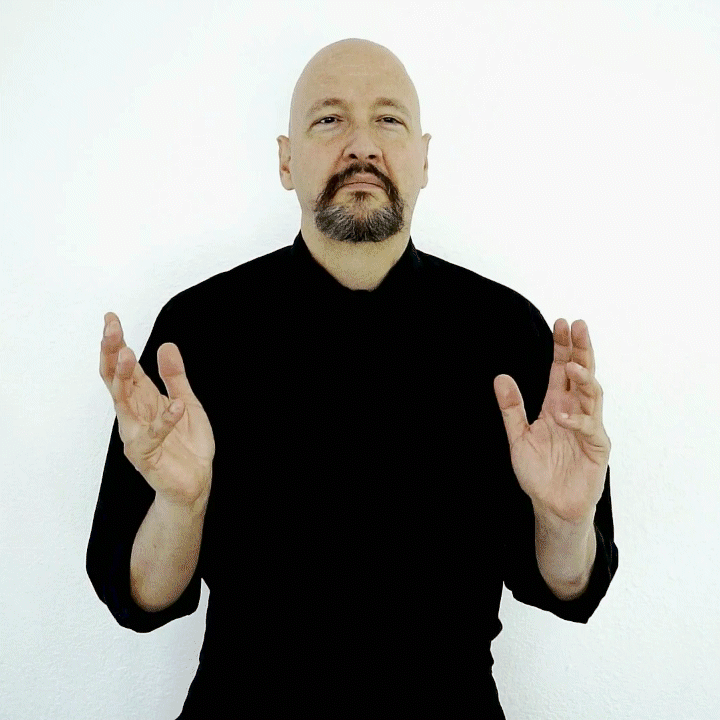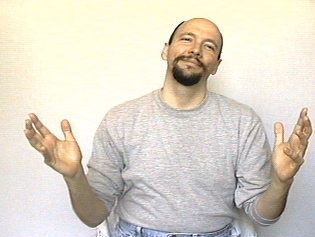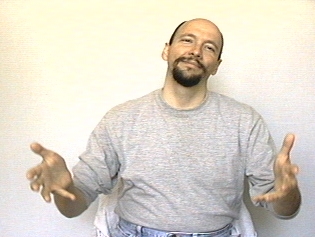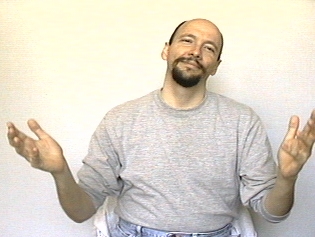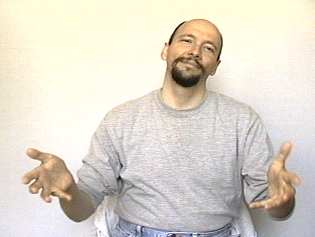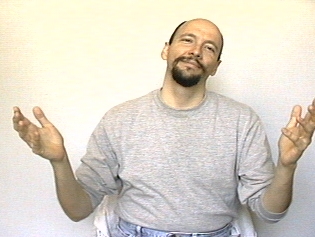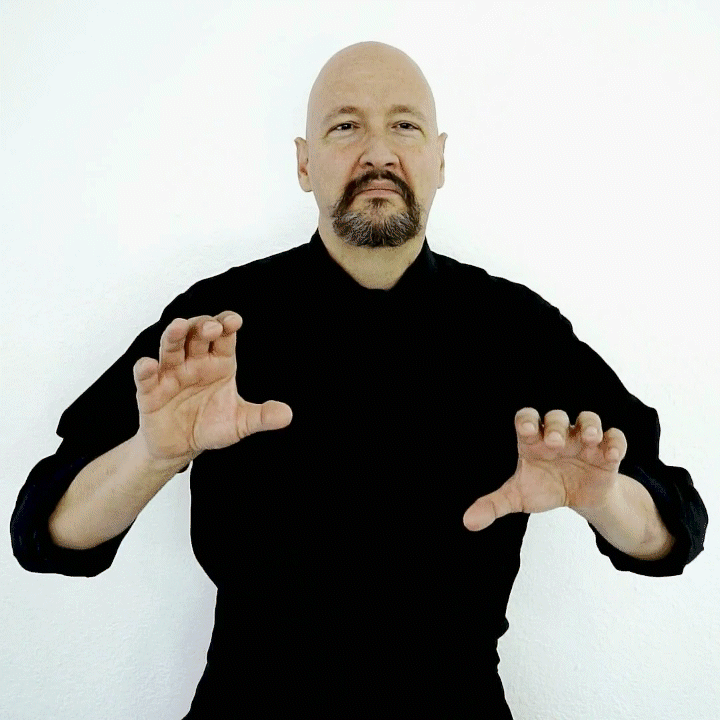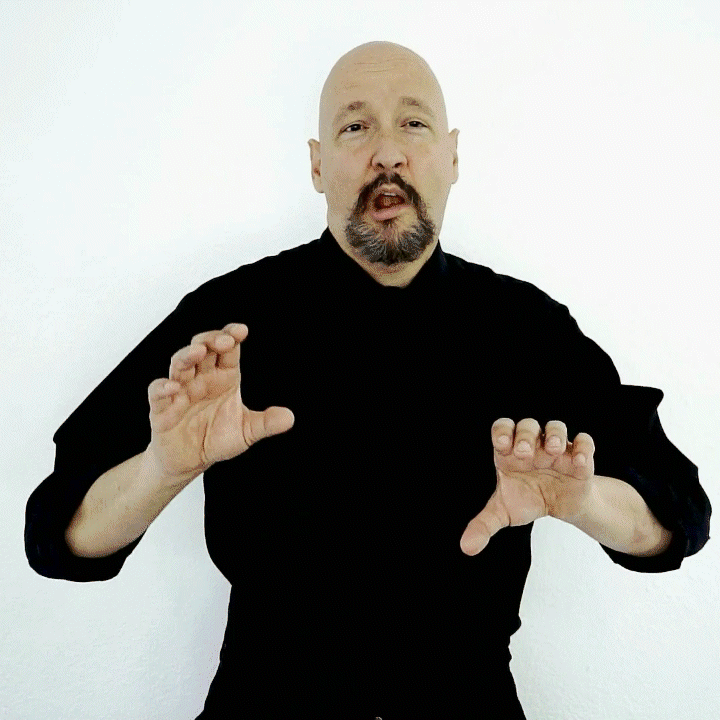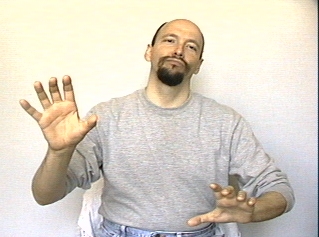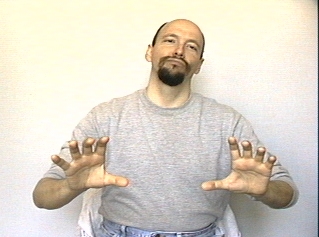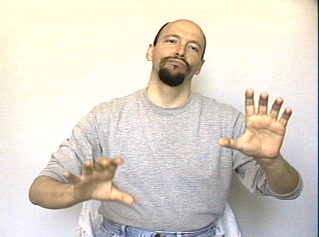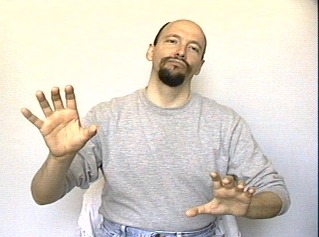American Sign Language: "chat"
The sign for "chat" has a couple of versions.
CHAT (version 1)
Sample sentence: Do you like to chat with Deaf people?
There is another way to sign "chat." This other version uses an alternating up and down movement.
CHAT (version 2)
CHAT (version 3)
Notes:
There are two popular versions of the sign for "chat" in which both hands move. (See the examples above.)
I honestly believe there is a slight difference in meaning between these two signs. Sort of like the difference in taste between Pepsi and a no-name brand cola. The difference is there, but it is not so much of a difference as to matter in everyday usage. To me, version one is more laid back and casual. Version two (with the forward facing "C" hands) is more active more involved. I don't see either as being "formal" though. I also don't consider one to be more clear or used more frequently than the other. For some reason, if I am talking about Hearing people chatting, I tend to use version one. I could also use version one for Deaf chatting, but would be less inclined to use version two for Hearing people chatting. But that is just me. I doubt you'd get much consensus on these signs, but it would be interesting to ask around. I'll have to do that one of these days.
The version of "chat" in which only one hand moves seems to me to mean more along the lines of "[he/she/that person was] chatting away" -- resulting more in a one-sided conversation -- but again, as with the other two versions - the one-hand-moving version can also mean "chat in general."
-- Dr. Bill
In a message dated 6/6/2006 11:26:18 AM Pacific Daylight Time, johnnyarkoosh@____ writes:Dr. Bill,
Thanks for the website. I don't know if you still update it regularly or not, but nonetheless I appreciate it.
I just wanted to comment on the "chat" sign version 2.
I agree that version 2 is primarily a "Deaf chat" and would not find myself using it concerning Hearing people. I do not know why that is either, but I did notice in chat version 2 you have on a more "Deaf face" which helps lend to the idea that it is a Deaf conversation.
I don't know how to explain what I am seeing, but the version 2 face is not a face I would make in relation to hearing people conversing. It is also a face much more closely related to version 2 than version 1. I don't think, regardless of circumstance that I make that particular face when I use version one, just something that really struck me.
Anyway, thanks again.
~ Johnny Arkoosh
Johnny,
Hey, thanks for the interesting observation.
I appreciate your comment.
-- Dr. Bill
7/29/2014: A community member writes:
I have some comments in response to your dictionary entry for <<CHAT>>. In relation to the comment by Johnny on 6.6.06 about your use of "a more ‘Deaf face'" with version 2, I can say that I've only known version 1, and have learned to expect and use that "Deaf face" mouth shape with that sign. (Maybe there's a more correct term for "mouth shape"?) I have seen Deaf people use version 1 in relation to Deaf people chatting with each other, but maybe you're right that it gets used less for that than version 2 does. Maybe I've been exposed less to version 2 because I'm not Deaf and have had fewer conversations about Deaf-only chatting. I don't know or remember if that mouth shape has a name, but I've learned it to imply a casual attitude. I expect you're aware of that, but maybe some of your readers wouldn't be (maybe including Johnny, since he said he didn't know how to explain what he was seeing). I use it in relation to signs about casually walking around or casually looking around too, for example. I do think of version 1 mainly in relation to chatting in ASL, but I have used it in relation to people chatting in English too. Since chatting is casual by definition, I've used that mouth shape in that context too in order to more fully express that. I'm intrigued by the distinctions you and Johnny perceive between the two versions of <<CHAT>>, and look forward to exploring those possibilities further.
- [a person who wishes to remain anonymous]
Later that same day (7/29/2014) "Anon" writes:
I remembered the term "mouth morpheme" and did a keyword search on your site to see if you used it. Found lots of good stuff about that, and about other morphemes too. I look forward to reading more of it all. This was particularly relevant to my previous comments:
Mouth morphemes are a part of ASL. This means certain mouth movements are intrinsic to being able to accurately represent ASL. Making a "th" -type of mouth shape is used to indicate recklessness or carelessness. Using an "mm" mouth shape is used to show that something is ordinary, uneventful, and being done or taking place in a regular manner.
So I see that my using the term "mouth shape" in that context was correct, and have learned or (probably) relearned from that passage that that particular mouth shape I mentioned can be referred to as the "mm" one. I appreciate your expanded definition of the meaning of the "mm" mouth shape too. I expect that "mouth shape" is used in ASL linguistics in a way similar to "handshape."
- Anon
Question: Is there a more correct term for "mouth shape"?
Answer: Some people use the term "mouth morpheme" but technically a mouth can have a shape that conveys has no specific meaning. In linguistics (the study of language) the term "morpheme" tends to mean something along the lines of: "A meaningful unit of language that can't be broken down smaller without losing meaning." The shape of the mouth is literally how the mouth, jaw, lips, and tongue are all arranged. If that arrangement is intended to convey a specific meaning it is considered to be a "mouth morpheme."
[ All of which is secondary to the question of whether or not it is my mouth and if there is food in it and whether that food is yummy or not. - Dr. Bill ]
Notes:Chat version: both hands in loose 5-hand shapes propelled at a forward/down angle brought back up and down again:
https://youtu.be/6KdtmP3ymSI
Chat version: one hand moving, forward facing loose C'hands:
https://youtu.be/vv8D34vy3pY
Chat version: two hands moving, forward facing loose C hands:
https://youtu.be/F9Qw3X_9d5c
Also see: TALK
Want to help support
ASL University? It's easy:
DONATE (Thanks!)
(You don't need a PayPal account. Just look for the credit card
logos and click continue.)
Another way to help is to buy something from the ASLU "Bookstore."
Want even more ASL resources? Visit the "ASL Training Center!" (Subscription
Extension of ASLU)
CHECK IT OUT >
Bandwidth slow? Check out "ASLUniversity.com" (a
free mirror of
Lifeprint.com less traffic, fast access)
VISIT >
You can learn
sign language
(ASL) online at American Sign Language University ™
Lifeprint.com © Dr. William Vicars
